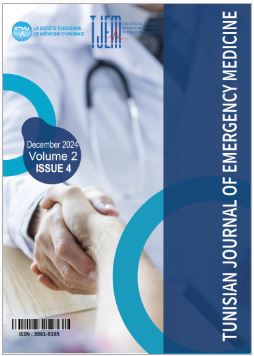Prehospital Particularities of Covid-19 infection and factors associated with its severity during the omicron variant wave (East-center of Tunisia)
- Authors
-
-
Rabeb Mbarek
Emergency medical service (EMS/SAMU03) Sahloul University Hospital, Sousse,Tunisia , -
Khouloud Hamdi
Emergency Department, Fattouma Bourguiba University Hospital, 5000 Monastir, Tunisia. , -
Sarra Soua
Faculty of Medicine of Sousse, University of Sousse, Sousse, Tunisia. , -
Hela Abroug
Departement of Epidemiology and Preventive Medicine, Monastir University Hospital, Monastir, Tunisia. , -
Sondes laajimi
Emergency medical service (EMS/SAMU03) Sahloul University Hospital, Sousse,Tunisia , -
haifa Bradai
Emergency medical service (EMS/SAMU03) Sahloul University Hospital, Sousse,Tunisia , -
Dorra Loghmari
Emergency medical service (EMS/SAMU03) Sahloul University Hospital, Sousse,Tunisia , -
Asma SRIHA
Department of Prevention and Security of Care, Sahloul University Hospital, Sousse, Tunisia , -
Semir Nouira
Emergency Department, Fattouma Bourguiba University Hospital, 5000 Monastir, Tunisia. ,
-
- Keywords:
- prehospital, Omicron variant wave, covid-19
- Abstract
-
Background: The Omicron variant of SARS-CoV-2, characterized by high transmissibility and
partial immune evasion, led to significant waves of COVID-19 globally. This study aimed to
evaluate the epidemiological and clinical characteristics of COVID-19 cases during the Omicron
wave in Tunisia, focusing on severity predictors.
Methods: A prospective study was conducted from January 1
st
to February 28
th
, 2022, in the
EMS03. Data were collected through patient records and follow-up interviews. COVID-19
severity was classified as mild, moderate, or severe per WHO guidelines. Predictors of severity
were identified through univariate and multivariate analyses.
Results: Among 2,948 calls received, 420 confirmed COVID-19 cases were analyzed. The mean
age was 48 years (±21.62), with 51% female. Comorbidities were present in 42.1% of cases, and 69.6% were vaccinated against COVID-19. The most reported symptoms were cough (67.5%), myalgia (61.2%), and fever (57.4%). Severe COVID-19 infection presentation was observed in
19.5% of cases, with 28.3% requiring hospitalization, 9.3% needing ICU care, and a mortality rate
of 15.5%. Predictors of severity included advanced age, male sex, comorbidities, low education
level, and lack of vaccination. Vaccinated individuals exhibited reduced severity, but severity was
not significantly associated with the number of doses or type of vaccine.
Conclusion: The Omicron wave presented predominantly symptomatic cases with milder disease
severity compared to earlier variants. However, age, comorbidities, and vaccination status
significantly influenced outcomes. Enhanced vaccination coverage remains critical in mitigating
severe COVID-19. - Downloads
- Published
- 28-12-2024
- Section
- Prospective study
- License
-
Copyright (c) 2024 Tunisian Journal of Emergency Medicine

This work is licensed under a Creative Commons Attribution-NonCommercial-ShareAlike 4.0 International License.


